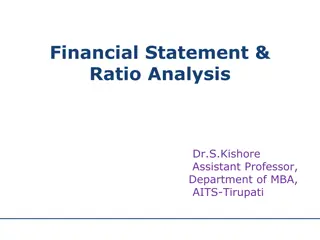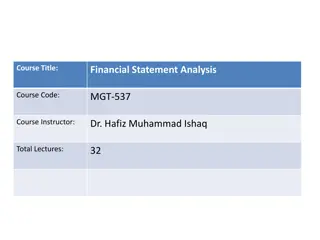
Financial Statements Analysis: Objectives, Types, and Procedures
Explore the meaning and importance of financial statement analysis, including objectives, types, and procedures. Learn how to assess a firm's financial strength, profitability, and operational efficiency through various analytical tools and techniques. Discover ways to make informed decisions, compare firms, and forecast future prospects based on financial data.
Download Presentation

Please find below an Image/Link to download the presentation.
The content on the website is provided AS IS for your information and personal use only. It may not be sold, licensed, or shared on other websites without obtaining consent from the author. If you encounter any issues during the download, it is possible that the publisher has removed the file from their server.
You are allowed to download the files provided on this website for personal or commercial use, subject to the condition that they are used lawfully. All files are the property of their respective owners.
The content on the website is provided AS IS for your information and personal use only. It may not be sold, licensed, or shared on other websites without obtaining consent from the author.
E N D
Presentation Transcript
CHAPTER OBJECTIVES Meaning and concept of financial analysis. Objectives and importance of financial analysis. Types of financial analysis. Procedure of financial statement analysis. Tools and techniques of financial statement analysis. Comparative statements, trend analysis, and common size statements. Limitations of financial analysis.
MEANING OF FINANCIAL STATEMENT ANALYSIS The term financial analysis , also known as analysis and interpretation of financial statements , refers to the process of determining financial strengths and weaknesses of the firm by establishing strategic relationship between the items of the balance sheet, profit and loss account and other operative data.
DEFINITIONS Analysing financial statements, according to Metcalf and Titard, is a process of evaluating the relationship between component parts of a financial statement to obtain a better understanding of a firm s position and performance. In the words of Myers, Financial statement analysis is largely a study of relationship among the various financial factors in a business as disclosed by a single set of statements, and a study of the trend of these factors as shown in a series of statements.
OBJECTIVES AND IMPORTANCE OF FINANCIAL STATEMENT ANALYSIS To assess the earning capacity or profitability of the firm. To assess the operational efficiency and managerial effectiveness. To assess the short term as well as long term solvency position of the firm. To identify the reasons for change in profitability and financial position of the firm. To make inter-firm comparison. To make forecasts about future prospects of the firm. To assess the progress of the firm over a period of time. To help in decision making and control. To guide or determine the dividend action. To provide important information for granting credit.
PROCEDURE OF FINANCIAL STATEMENTS ANALYSIS The analyst should acquaint himself with the principles and postulates of accounting. The extent of analysis should be determined so that the sphere of work may be decided. The financial data given in the statements should be re organised and re arranged. A relationship is established among financial statements with the help of tools and techniques of analysis such as ratios, trends, common size, funds flow etc. The information is interpreted in a simple and understandable way. The significance and utility of financial data is explained for helping decision taking. The conclusions drawn from interpretation are presented to the management in the form of reports.
TOOLS/METHODS OR TECHNIQUES OF FINANCIAL STATEMENT ANALYSIS Common size statements Comparative statements Funds flow analysis Trend analysis Cash flow analysis Cost-volume- profit analysis Ratio analysis
COMPARATIVE STATEMENTS The comparative financial statements are statements of the financial position at different periods; of time. The elements of financial position are shown in a comparative form so as to give an idea of financial position at two or more periods. The two comparative statements are (i) Balance sheet, and (ii) Income statement.
COMPARATIVE BALANCE SHEET Comparative balance sheet of an enterprise is prepared to show different assets, liabilities and capital as on two or more dates so as to compare and ascertain any increase or decrease in absolute items and also percentages changes. A comparative balance sheet contains the following columns : (i) Particulars column. (ii) Data of Previous period/year s balance sheet. (iii) Data of the current year s balance sheet. (iv) Increase or decrease in the absolute data. (v) Percentage change of increase or decrease in data.
FORMAT OF COMPARATIVE BALANCE SHEET Comparative Balance Sheet as at 31stMarch 2015 and 2016 Absolute Change (Increase or Decrease) (5) Percentage Change (Increase or Decrease) (6) Particulars (1) 31-3-2015 (3) 31-3-2016 (4) Note No (2) D = C/A 100 % A ` B ` C = B A ` I. Equity And Liabilities (1) Shareholder's Funds (a) Share Capital (b) Reserve and Surplus (2) Non Current Liabilities : ... ... ... ... ... .. ... ... (a) Long term Borrowings ... ... ... ... (b) Long term Provisions (3) Current Liabilities : (a) Short term Borrowings ... ... ... .. ... ... ... ... (b) Trade Payable (c) Other Current Liabilities ... ... ... ... ... ... ... ... (d) Short-term Provisions ... ... ... ... Total II. Assets : (1) Non-Current Assets : (a) Fixed Assets : (i) Tangible Assets (ii) Intangible Assets (b) Non-Current Investment ... ... ... ... ... ... ... ... ... ... ... ...
... ... ... ... (c) Long-term loans and advances (2) Current Assets : (a) Current investment ... ... ... ... (b) Inventories ... ... ... ... (c) Trade Receivables ... ... ... ... ... ... ... ... (d) Cash and Cash Equivalents ... ... ... ... (e) Short-term loans and advances (d) Other Current Assets ... ... ... ... TOTAL ... ... ... ...
COMPARATIVE INCOME STATEMENT OR STATEMENT OF PROFIT AND LOSS The income statement gives the results of the operations of a business. It shows the net profit or net loss on account of business operations. The comparative income statement gives an idea of the progress of a business over a period of time. A comparative income statement, contains the following columns : Particulars column. Data of previous period/year s statement of profit and loss. Data of current period/year s statement of profit and loss. Increase or decrease in the absolute data. Percentage change of increase or decrease.
FORMAT OF COMPARATIVE STATEMENT OF PROFIT AND LOSS COMPARATIVE STATEMENT OF PROFIT AND LOSS for the years ended 31st March 2015 and 2016 Absolute Change (Increase or Decrease) Percentage Change (Increase or Decrease) Note No. Particulars 31.3.2015 31.3.2016 ` ` ` % 1 2 3 4 5 A B C = (B A) D = C/A 100 I. Revenue from Operations ... ... ... ... II. Add : Other Incomes ... ... ... ... III. Total Revenue I + II ... ... ... IV. Less : Expenses
Cost of Materials Consumed ... ... ... ... Purchase of Stock-in Trade ... ... ... ... Changes in Inventories of Finished Goods, Work-in-Progress and Stock-in-Trade ... ... ... Employee Benefit Expenses ... ... ... ... Finance Costs ... ... ... ... Depreciation and Amortization Expenses ... ... ... ... Other Expenses ... ... ... ... Total Expenses ... ... ... ... V. Profit before Tax (III IV) ... ... ... ... VI. Less : Tax ... ... ... ... VII. Profit after Tax (V VI) ... ... ... ...
COMMONSIZE BALANCE SHEET A statement in which balance sheet items are expressed as the ratio of each asset to total assets and the ratio of each liability is expressed as a ratio of total liabilities is called common size balance sheet.
COMMON SIZE STATEMENT OF PROFIT AND LOSS The items in statement of profit and loss can be shown as percentages of revenue from operations (sales) to show the relation of each item to sales. A significant relationship can be established between items of income statement and volume of sales.
TREND ANALYSIS The financial statements may be analysed by computing trends of series of information. This method determines the direction upwards or downwards and involves the computation of the percentage relationship that each statement item bears to the same item in base year. The information for a number of years is taken up and one year, generally the first year, is taken as a base year. The figures of the base year are taken as 100 and trend ratios for other years are calculated on the basis of base year. The analyst is able to see the trend of figures, whether upward or downward.
LIMITATIONS OF FINANCIAL ANALYSIS It is only a study of interim reports Financial analysis is based upon only monetary information and non monetary factors are ignored. It does not consider changes in price levels. As the financial statements are prepared on the basis of a going concern, it does not give exact position. Thus accounting concepts and conventions cause a serious limitation to financial analysis. Changes in accounting procedure by a firm may often make financial analysis misleading. Analysis is only a means and not an end in itself. The analyst has to make interpretation and draw his own conclusions. Different people may interpret the same analysis in different ways.






















